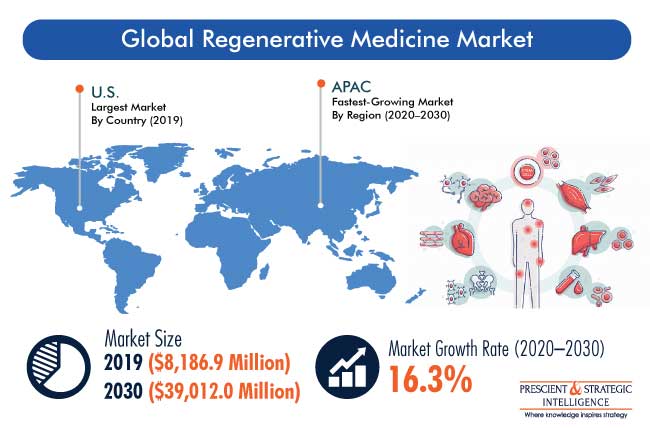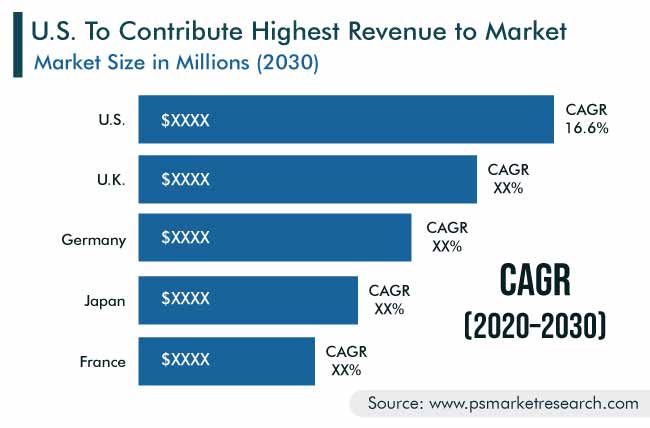Report Code: 11128 | Available Format: PDF | Pages: 161
Regenerative Medicine Market Research Report: By Type (Cell Therapy, Gene Therapy, Tissue Engineered Products), Application (Musculoskeletal, Wound Care, Oncology, Dental, Ocular) - Global Industry Analysis and Demand Forecast to 2030
- Report Code: 11128
- Available Format: PDF
- Pages: 161
- Report Description
- Table of Contents
- Market Segmentation
- Request Free Sample
Regenerative Medicine Market Overview
The global regenerative medicine market was valued at $8,186.9 million in 2019, and it is expected to progress at a CAGR of 16.3% during the forecast period (2020–2030). The major factors responsible for the growth of the market include the increasing technological advancements, rising number of government initiatives, surging cases of chronic and genetic diseases, rapidly growing geriatric population, and hiking demand for organ transplants.
Due to the COVID-19 pandemic, governments across the world have taken strong measures, such as lockdowns and social distancing, to ensure the safety of citizens and contain the spread of the infection. Quite evidently, the complete focus of the healthcare system has been on finding a novel treatment for the coronavirus for a while now. Moreover, due to the unavailability of participants for clinical trials and other research activities, the market for regenerative medicine was negatively impacted. However, with the increasing adoption of regenerative medicine in treating chronic and viral diseases such as COVID-19, the market is expected to recover by the first or second quarter of 2021.

Due to Rising Number of Clinical Trials, Cell Therapy Category To Witness Fastest Growth
Based on type, the cell therapy category is expected to witness the fastest growth in the regenerative medicine market during the forecast period. This can be attributed to the rising number of clinical trials involving various cell therapy techniques.
High Prevalence Helping Musculoskeletal Disease Be Largest Application Area in Market
Based on application, the musculoskeletal category held the largest share in the regenerative medicine industry during the historical period (2014–2019), and it is expected to retain its position in the coming years. This will majorly be due to the rising cases of musculoskeletal diseases, coupled with the growing geriatric population and expanding pipeline of stem cell products for the treatment of such disorders.
Owing to Growing Healthcare Expenditure, North America Leads Market
Geographically, North America accounted for the largest share in the regenerative medicine market in 2019, and it is expected to maintain its position in the coming years. This is majorly ascribed to the advancements in the field of tissue engineering, rising number of stem cell banks, growing healthcare expenditure, and surging adoption of stem cell therapy for chronic diseases.
However, the Asia-Pacific (APAC) region is expected to grow at the highest CAGR during the forecast period. This would mainly be due to the growing economy, rising private and public funding in research organizations, surging cases of chronic diseases, booming geriatric population, and expanding medical tourism sector.

Collaborations and Partnerships Are Key Market Trends
In the global regenerative medicine market, several players have adopted collaboration and partnership strategies for the development of advanced therapies. For instance, in November 2019, Lonza Group Ltd. and DiNAQOR AG entered into a collaboration to advance the latter’s preclinical gene therapy programs for the treatment of cardiac myosin-binding protein-C (MYBPC3) cardiomyopathies. The increasing number of collaborations and partnerships is accompanied by the increasing investment by biopharmaceutical companies in research and development (R&D) and an expansion of their product portfolio.

Increasing Technological Advancements Driving Availability of Regenerative Medicines
Large biotech and pharma companies in the regenerative medicine market are investing more than ever on technological advancements in order to offer more-effective gene therapies. One of the recent advancements in the technologies involved in regenerative medicine is the advent of 3D bioprinting. It is being used to develop complex tissue structures to mimic native organs and tissues. For instance, in August 2019, Techshot Inc. collaborated with nScrypt Inc. to launch a 3D BioFabrication Facility (BFF), which will use adult-tissue-derived proteins and adult human cells, such as pluripotent cells or stem cells, as a source to create viable tissue.
Increasing Interest of Government Research Institutes in Advancing Regenerative Medicine
Governments worldwide are implementing policy changes to jump-start research developments across many fields, to establish regenerative medicine as a new medical discipline. For instance, 22 of the 27 U.S. National Institutes of Health (NIH) received heavy funding for regenerative medicine research during 2012–2014. Six of these institutes further provided 7% or more of the funding as regenerative medicine grants to external researchers and institutes.
Growing Prevalence of Chronic Diseases and Genetic Disorders
The increasing cases of chronic diseases and genetic disorders across the world act as a major driver for the regenerative medicine market. For instance, globally, approximately one in three adults suffer from multiple chronic conditions. Moreover, according to the World Health Organization (WHO), around 17.9 million people die each year from cardiovascular diseases (CVDs), accounting for around 31% of the total deaths worldwide.
| Report Attribute | Details |
Historical Years |
2014-2019 |
Forecast Years |
2020-2030 |
Base Year (2019) Market Size |
$8,186.9 Million |
Forecast Period CAGR |
16.3% |
Report Coverage |
Market Trends; Revenue Estimation and Forecast; Segmentation Analysis; Regional Breakdown; Competitive Analysis; Companies’ Strategic Developments; Product Benchmarking; Company Profiling |
Market Size by Segments |
By Type; By Application; By Region |
Market Size of Geographies |
China; India; Japan; South Korea; Singapore; U.S.; Canada; Mexico; Brazil; Germany; U.K.; France; Spain; Italy; Saudi Arabia; South Africa |
Secondary Sources and References (Partial List) |
Agency for Medical Research and Development; Alliance for Regenerative Medicine; California Institute for Regenerative Medicine; Canadian Institutes of Health Research; Centers for Disease Control and Prevention; European Medicines Agency; European Regulatory Agency; European Union; GLOBOCAN; International Diabetes Federation |
Explore more about this report - Request free sample
Market Players Are Focusing on Product Launches and Approvals to Gain Competitive Edge
The global regenerative medicine market is fragmented in nature, as it comprises various key players, such as Smith & Nephew plc, 3M Company, Integra LifeSciences Holdings Corporation, Wright Medical Group N.V., Stryker Corporation, Zimmer Biomet Holdings Inc., Novartis AG, Amgen Inc., Allergan plc, MiMedx Group Inc., and Organogenesis Holdings Inc.
In recent years, players in the regenerative medicine industry have been actively involved in product launches and approvals to cut through the strong market competition.
- In December 2020, Novartis AG announced that the European Commission (EC) has approved Leqvio (inclisiran) for the treatment of adults with hypercholesterolemia or mixed dyslipidemia. This approval is based on the results of the ORION clinical development program, specifically, a sustained low-density lipoprotein cholesterol (LDL-C) reduction of up to 52% in patients with elevated LDL-C, despite maximally tolerated statin therapy.
- In October 2020, Novartis AG announced the receipt of the marketing authorization from the Ministry of Health, Labour and Welfare of Japan for the Foundation for Biomedical Research and Innovation at Kobe (FBRI) to manufacture and supply commercial Kymriah (tisagenlecleucel) in the country. This approval makes FBRI the first and only approved commercial manufacturing site for chimeric antigen receptor T (CAR-T) cell therapy in Asia.
Key Players in Regenerative Medicine Industry Include:
-
Smith & Nephew plc
-
3M Company
-
Integra LifeSciences Holdings Corporation
-
Wright Medical Group N.V.
-
Stryker Corporation
-
Zimmer Biomet Holdings Inc.
-
Novartis AG
-
Amgen Inc.
-
Allergan plc
-
MiMedx Group Inc.
-
Organogenesis Holdings Inc.
-
Misonix Inc.
-
Takeda Pharmaceutical Company Limited
-
Vericel Corporation
Market Size Breakdown by Segment
The global regenerative medicine market report offers comprehensive market segmentation analysis along with market estimation for the period 2014–2030.
Based on Type
- Cell Therapy
- Stem cell therapy
- Autologous
- Allogenic
- Somatic cell therapy
- Autologous
- Allogenic
- Stem cell therapy
- Gene Therapy
- Viral
- Non-viral
- Tissue Engineered Products
- Cell-based
Based on Application
- Musculoskeletal
- Wound Care
- Oncology
- Dental
- Ocular
Geographical Analysis
- North America
- U.S.
- Canada
- Europe
- U.K.
- Germany
- France
- Italy
- Spain
- Asia-Pacific (APAC)
- Japan
- South Korea
- China
- India
- Singapore
- Latin America (LATAM)
- Brazil
- Mexico
- Middle East and Africa (MEA)
- Saudi Arabia
- South Africa
The 2019 size of the regenerative medicine market was $8,186.9 million.
Initially, the COVID-19 impact on the regenerative medicine industry was negative; however, in 2021, the situation is expected to act as a key market driver.
The largest category under the application segment of the regenerative medicine market is musculoskeletal.
APAC will witness the fastest regenerative medicine industry growth.
The nature of the regenerative medicine market is fragmented.
Want a report tailored exactly to your business strategy?
Request CustomizationWant an insight-rich discussion with the report author?
Speak to AnalystOur dedication to providing the most-accurate market information has earned us verification by Dun & Bradstreet (D&B). We strive for quality checking of the highest level to enable data-driven decision making for you
Our insights into the minutest levels of the markets, including the latest trends and competitive landscape, give you all the answers you need to take your business to new heights
With 24/7 research support, we ensure that the wheels of your business never stop turning. Don’t let time stand in your way. Get all your queries answered with a simple phone call or email, as and when required
We take a cautious approach to protecting your personal and confidential information. Trust is the strongest bond that connects us and our clients, and trust we build by complying with all international and domestic data protection and privacy laws